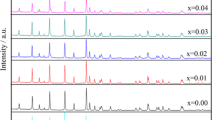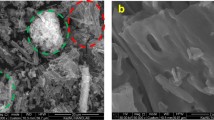Abstract
The mechanism of magnesium compounds on the crystal structure, morphology, and electrochemical properties of LiFePO4 has been investigated using magnesium oxide, magnesium sulfate, and magnesium hydrogen phosphate as dopants. The shrinkage of crystal cell and lattice spacing implies that Mg2+ is successfully doped into the lattice of LiFePO4, since magnesium ions occupy less space than ferrous ions or lithium ions. Meanwhile, the primary particle size of LiFePO4 tends to reduce when high-content magnesium is doped, which is ascribed to cell shrinkage as well as the reduction of surface energy. In addition, agglomeration of crystal fine particles is observed in the SEM images. The discharge capacity of 1%MgHPO4-LFP increases as the proceeding of the charging/discharging cycle; i.e., the retention rate of this sample exceeds 100% (100.96%) at 0.5 C after 30 cycles. Owing to the substitution of S for O sites, the diffusion channel of Li+ expands while the total number of Fe-Li reverse site defects decreases, which lowers the capacity attenuation of 10%MgSO4-LFP under high-rate conditions (compared to 10%MgO-LFP). The discharge capacity of 10%MgSO4-LFP is 88.7 mAh/g, which is higher than 10%MgO-LFP (75.06 mAh/g).










Similar content being viewed by others
Data availability
All data generated and analyzed during this study are available from the corresponding author on reasonable request.
References
Mwizerwa JP, Liu C, Xu K, Zhao N, Chen Z, Shen J (2022) In-situ solution phase synthesis of LiFePO4@VSe2 composite as highly active cathode for Li-ion batteries. J Alloys Compd 901:163639. https://doi.org/10.1016/j.jallcom.2022.163639
Jyoti J, Singh BP, Tripathi SK (2021) Recent advancements in development of different cathode materials for rechargeable lithium ion batteries. J Energy Storage 43:103112. https://doi.org/10.1016/j.est.2021.103112
Guan S, Hu Z, Dong Y, Chang Q, Yuan S, Xiong J, Jiang G (2021) A facile solvothermal synthesis of Mn-doped LiFePO4 nanoplates with improved electrochemical performances. Ionics 27:21–30. https://doi.org/10.1007/s11581-019-03319-4
Chung SY, Bloking JT, Chiang YM (2002) Electronically conductive phospho-olivines as lithium storage electrodes. Nat Mater 1:123–128. https://doi.org/10.1038/nmat732
Ni J, Zhao Y, Chen J, Gao L, Lu L (2014) Site-dependent electrochemical performance of Mg doped LiFePO4. Electrochem Commun 44:4–7. https://doi.org/10.1016/j.elecom.2014.04.004
Yan C, Wu K, Jing P, Luo H, Zhang Y (2022) Mg-doped porous spherical LiFePO4/C with high tap-density and enhanced electrochemical performance. Mater Chem Phys 280:125711. https://doi.org/10.1016/j.matchemphys.2022.125711
Örnek A, Efe O (2015) Doping qualifications of LiFe1-xMgxPO4-C nano-scale composite cathode materials. Electrochim Acta 166:338–349. https://doi.org/10.1016/j.electacta.2015.03.010
Liu X, Zhang Y, Meng Y, Kang T, Gao H, Huang L, Zhu F (2022) Influence mechanism of Mg2+ doping on electrochemical properties of LiFePO4 cathode materials. ACS Appl Energy Mater 5:8452–8459. https://doi.org/10.1021/acsaem.2c00986
Shu H, Wang X, Wu Q, Hu B, Yang X, Wei Q, Liang Q, Bai Y, Zhou M, Wu C, Chen M, Wang A, Jiang L (2013) Improved electrochemical performance of LiFePO4/C cathode via Ni and Mn co-doping for lithium-ion batteries. J Power Sources 237:149–155. https://doi.org/10.1016/j.jpowsour.2013.03.035
Wang D, Li H, Shi S, Huang X, Chen L (2005) Improving the rate performance of LiFePO4 by Fe-site doping. Electrochim Acta 50:2955–2958. https://doi.org/10.1016/j.electacta.2004.11.045
Ou X, Liang G, Wang L, Xu S, Zhao X (2008) Effects of magnesium doping on electronic conductivity and electrochemical properties of LiFePO4 prepared via hydrothermal route. J Power Sources 184:543–547. https://doi.org/10.1016/j.jpowsour.2008.02.077
Zhao D, Yu Y, Cao C, Wang J, Wang E, Cao Y (2015) The existing states of doped B3+ ions on the B doped TiO2. Appl Surf Sci 345:67–71. https://doi.org/10.1016/j.apsusc.2015.03.140
Li Z, Ren X, Zheng Y, Tian W, An L, Sun J, Ding R, Wen L, Liang G (2020) Effect of Ti doping on LiFePO4/C cathode material with enhanced low-temperature electrochemical performance. Ionics (Kiel) 26:1599–1609. https://doi.org/10.1007/s11581-019-03408-4
Choi H, Seo JY, Kim CS (2021) Effect of Mg shallow doping on structural and magnetic properties of LiFePO4 triphylite. IEEE Trans Magn 57:1–5. https://doi.org/10.1109/TMAG.2020.3014728
Li Y, Geng G, Hao J, Zhang J, Yang C, Li B (2015) Optimized synthesis of LiFePO4 composites via rheological phase assisted method from FePO4 with acetic acid as dispersant. Electrochim Acta 186:157–164. https://doi.org/10.1016/j.electacta.2015.10.121
Li Y, Hao J, Geng G, Wang Y, Shang X, Yang C, Li B (2015) Large-scale preparation of Mg doped LiFePO4@C for lithium ion batteries via carbon thermal reduction combined with aqueous rheological phase technology. RSC Adv 5:68681–68687. https://doi.org/10.1039/c5ra11680e
Fan CL, Lin CR, Han SC, Chen J, Li LF, Bai YM, Zhang KH, Zhang X (2014) Structure, conductive mechanism and electrochemical performances of LiFePO4/C doped with Mg2+, Cr3+ and Ti4+ by a carbothermal reduction method. New J Chem 38:795–801. https://doi.org/10.1039/c3nj01285a
Liu X-H, Zhao Z-W (2014) Synthesis of LiFePO4/C doped with Mg2+ by reactive extrusion method. Adv Powder Technol 25:1339–1344. https://doi.org/10.1016/j.apt.2014.03.013
Song J, Zhang Y, Shao G (2013) Comparing the electrochemical performance of LiFePO4/C modified by Mg doping and MgO coating. J Nanomater 2013:687501. https://doi.org/10.1155/2013/687501
Wang B, Xu B, Liu T, Liu P, Guo C, Wang S, Wang Q, Xiong Z, Wang D, Zhao XS (2014) Mesoporous carbon-coated LiFePO4 nanocrystals co-modified with graphene and Mg2+ doping as superior cathode materials for lithium ion batteries. Nanoscale 6:986–995. https://doi.org/10.1039/c3nr04611g
Arumugam D, Paruthimal Kalaignan G, Manisankar P (2009) Synthesis and electrochemical characterizations of nano-crystalline LiFePO4 and Mg-doped LiFePO4 cathode materials for rechargeable lithium-ion batteries. J Solid State Electrochem 13:301–307. https://doi.org/10.1007/s10008-008-0533-3
Yaroslavtsev S, Novikova S, Rusakov V, Vostrov N, Kulova T, Skundin A, Yaroslavtsev A (2018) LiFe1-XMgXPO4/C as cathode materials for lithium-ion batteries. Solid State Ionics 317:149–155. https://doi.org/10.1016/j.ssi.2018.01.011
Ding YH, Zhang P (2012) Effect of Mg and Co co-doping on electrochemical properties of LiFePO4. Trans Nonferrous Met Soc China 22:s153–s156. https://doi.org/10.1016/S1003-6326(12)61701-4
Novikova S, Yaroslavtse S, Rusakov V, Kulova T, Skundin A, Yaroslavtsev A (2014) LiFe1-xMIIxPO4/C (MII = Co, Ni, Mg) as cathode materials for lithium-ion batteries. Electrochim Acta 122:180–186. https://doi.org/10.1016/j.electacta.2013.08.118
Wang L, Wei R, Zhang H, Zhang K, Liang F, Yao Y, Li Y (2022) B-Mg co-doping behavior of LiFePO4 cathode material: balance of oxygen vacancy and enhancement of electrochemical performance. Ionics (Kiel) 28:593–600. https://doi.org/10.1007/s11581-021-04349-7
Huang X, Yao Y, Liang F, Dai Y (2018) Concentration-controlled morphology of LiFePO4 crystals with an exposed (100) facet and their enhanced performance for use in lithium-ion batteries. J Alloys Compd 743:763–772. https://doi.org/10.1016/j.jallcom.2018.02.048
Wang L, He X, Sun W, Wang J, Li Y, Fan S (2012) Crystal orientation tuning of LiFePO4 nanoplates for high rate lithium battery cathode materials. Nano Lett 12:5632–5636. https://doi.org/10.1021/nl3027839
Dokko K, Koizumi S, Nakano H, Kanamura K (2007) Particle morphology, crystal orientation, and electrochemical reactivity of LiFePO4 synthesized by the hydrothermal method at 443 K. J Mater Chem 17:4803–4810. https://doi.org/10.1039/b711521k
Okada K, Kimura I, Machida K (2018) High rate capability by sulfur-doping into LiFePO4 matrix. RSC Adv 8:5848–5853. https://doi.org/10.1039/c7ra12740e
Ait Salah A, Jozwiak P, Zaghib K, Garbarczyk J, Gendron F, Mauger A, Julien CM (2006) FTIR features of lithium-iron phosphates as electrode materials for rechargeable lithium batteries. Spectrochim Acta Part A 65:1007–1013. https://doi.org/10.1016/j.saa.2006.01.019
Qin X, Wang J, Xie J, Li F, Wen L, Wang X (2012) Hydrothermally synthesized LiFePO4 crystals with enhanced electrochemical properties: Simultaneous suppression of crystal growth along [010] and antisite defect formation. Phys Chem Chem Phys 14:2669–2677. https://doi.org/10.1039/c2cp23433e
Wang Y, Zhang J, Xue J, Ke X, Liang G (2021) LiFePO4/C composites with high compaction density as cathode materials for lithium-ion batteries with high volumetric energy density. Ionics (Kiel) 27:4687–4694. https://doi.org/10.1007/s11581-021-04078-x
Mwizerwa JP, Liu C, Xu K, Zhao N, Li Y, Chen Z, Shen J (2022) Three-dimensional printed lithium iron phosphate coated with magnesium oxide cathode with improved areal capacity and ultralong cycling stability for high performance lithium-ion batteries. J Colloid Interface Sci 623:168–181. https://doi.org/10.1016/j.jcis.2022.05.030
Gao Y, Zhang L, Feng S, Shen W, Guo S (2018) Improving the electrochemical properties of lithium iron(II) phosphate through surface modification with manganese ion(II) and reduced graphene oxide. J Solid State Electrochem 22:285–292. https://doi.org/10.1007/s10008-017-3757-2
Luo YZ, He LH, Liu XH (2015) Effect of Mg doping on electrochemical performance of Li3V2(PO4)3/C cathode material for lithium ion batteries. Trans Nonferrous Met Soc China 25:2266–2271. https://doi.org/10.1016/S1003-6326(15)63840-7
Author information
Authors and Affiliations
Contributions
Huiqian Mao: methodology, project administration, data curation, validation, investigation, software/writing—original draft
Kui Chen: conceptualization, funding acquisition, supervision, validation, writing—review and editing
Xianming Luo: resources, methodology
Bin Wu: validation, writing—review & editing
Mingjun Qu: investigation, validation
Yiming Xu: investigation, visualization
Gongsheng Zou: assistance
Corresponding author
Ethics declarations
Ethics approval
This article does not contain any studies with human participants or animals performed by any of the authors.
Competing interests
The authors declare no competing interests.
Additional information
Publisher’s note
Springer Nature remains neutral with regard to jurisdictional claims in published maps and institutional affiliations.
Rights and permissions
Springer Nature or its licensor (e.g. a society or other partner) holds exclusive rights to this article under a publishing agreement with the author(s) or other rightsholder(s); author self-archiving of the accepted manuscript version of this article is solely governed by the terms of such publishing agreement and applicable law.
About this article
Cite this article
Mao, H., Chen, K., Luo, X. et al. Effect of magnesium compounds on crystal structure, morphology, and electrochemical properties of LiFePO4/C. Ionics 29, 3525–3535 (2023). https://doi.org/10.1007/s11581-023-05089-6
Received:
Revised:
Accepted:
Published:
Issue Date:
DOI: https://doi.org/10.1007/s11581-023-05089-6




